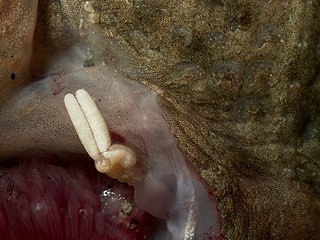
Digenea is a class of trematodes in the Platyhelminthes phylum, consisting of parasitic flatworms with a syncytial tegument and, usually, two suckers, one ventral and one oral. Adults commonly live within the digestive tract, but occur throughout the organ systems of all classes of vertebrates. Once thought to be related to the Monogenea, it is now recognised that they are closest to the Aspidogastrea and that the Monogenea are more closely allied with the Cestoda. Around 6,000 species have been described to date.

Strongyles, or alternatively, strongyls, are nematode worms of the family Strongylidae, order Strongylida. They are often parasitic in the gastrointestinal tract of mammals, especially grazers such as sheep, cattle and horses.

Plagiorchiida is a large order of trematodes, synonymous to Echinostomida. They belong to the Digenea, a large subclass of flukes. This order contains relatively few significant parasites of humans.

Chondracanthidae is a family of parasitic copepods, usually found infecting the branchial chamber of demersal fishes. It comprises the following genera:

Echinorhynchida is an order of parasitic worms in the phylum Acanthocephala. It contains the following families:

Rhadinorhynchidae is a family of parasitic worms from the order Echinorhynchida.

Opisthorchiidae is a family of digenean trematodes. Opisthorchiidae have cosmopolitan distribution.

Opecoelidae is a family of trematodes. It is the largest digenean family with over 90 genera and nearly 900 species, almost solely found in marine and freshwater teleost fishes. It was considered by Bray et al. to belong in the superfamily Opecoeloidea Ozaki, 1925 or the Brachycladioidea Odhner, 1905.

Satyu Yamaguti was a Japanese parasitologist, entomologist, and helminthologist. He was a specialist of mosquitoes and helminths such as digeneans, monogeneans, cestodes, acanthocephalans and nematodes. He also worked on the parasitic crustaceans Copepoda and Branchiura. Satyu Yamaguti wrote more than 60 scientific papers and, more importantly, several huge monographs which are still in use by scientists all over the world and were cited over 1,000 times each.

Capsalidae is a family of monopisthocotylean monogeneans, which includes about 200 species.

Echinostomatidae is a family of trematodes in the order Plagiorchiida, first described in 1899.

Lepocreadiidae is a family of trematodes in the order Plagiorchiida.

The Interim Register of Marine and Nonmarine Genera (IRMNG) is a taxonomic database which attempts to cover published genus names for all domains of life, from 1758 in zoology up to the present, arranged in a single, internally consistent taxonomic hierarchy, for the benefit of Biodiversity Informatics initiatives plus general users of biodiversity (taxonomic) information. In addition to containing just over 500,000 published genus name instances as at May 2023, the database holds over 1.7 million species names, although this component of the data is not maintained in as current or complete state as the genus-level holdings. IRMNG can be queried online for access to the latest version of the dataset and is also made available as periodic snapshots or data dumps for import/upload into other systems as desired. The database was commenced in 2006 at the then CSIRO Division of Marine and Atmospheric Research in Australia and, since 2016, has been hosted at the Flanders Marine Institute (VLIZ) in Belgium.
Metamicrocotyla is a genus which belongs to the family Microcotylidae and class Monogenea. It was created by Yamaguti in 1953 to include Metamicrocotyla bora and Metamicrocotyla filiformis from the gills off the flathead grey mullet Mugil cephalus (Mugilidae). As all Monogenea, species of Metamicrocotyla are ectoparasites that affect their host by attaching themselves as larvae on the gills of the fish and grow into adult stage. This larval stage is called oncomiracidium, and is characterized as free swimming and ciliated. Members of Metamicrocotyla are characterized by a symmetrical haptor, a variable number of postovarian testes and with no cirrus nor vagina. their genital atrium is provided with paired groups of spines or hooks.
Azygiida is an order of flatworms belonging to the class Rhabditophora.

Anomalocardia is a genus of bivalves belonging to the family Veneridae.
Cryptogonimidae is a family of trematodes belonging to the order Plagiorchiida.
Synhimantus is a genus of nematodes belonging to the family Acuariidae.
Skrjabinoclava is a genus of nematodes belonging to the family Acuariidae.
Acanthoparyphium is a genus of flatworms belonging to the family Himasthlidae.













